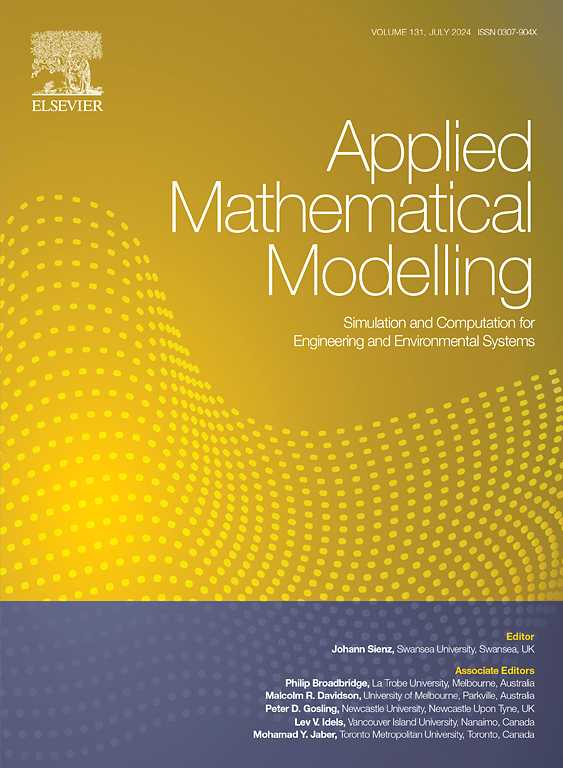利用分层半监督高斯混合分类器,基于不完整传感器变量进行故障诊断
IF 4.4
2区 工程技术
Q1 ENGINEERING, MULTIDISCIPLINARY
引用次数: 0
摘要
我们提出了一种基于部分不完整和无标记样本的分层半监督变异半贝叶斯高斯混合分类器,用于机械和电气系统的故障诊断。这些系统通常结构复杂,由多个传感器同时监控。由于传感器故障或传输错误,采集数据中的某些传感器变量可能不完整。此外,标注数据可能是一项耗时耗力的工作,导致许多样本未标注。为了应对这些挑战,我们将缺失的传感器变量和不可用的标签视为隐藏值,并在期望最大化算法的框架内进行处理。我们采用半贝叶斯技术和变异推理来估计模型参数。具体来说,我们为均值和协方差矩阵引入了先验分布,以解决经验协方差矩阵可能存在的奇异性问题。加权系数不加入先验分布,这样它们的值就可以衰减为零,从而有效去除混合模型中的冗余成分。利用因子化分布来逼近模型参数的后验分布,以及缺失标签和其他潜在变量的后验分布。为了验证所提技术的有效性,我们进行了数值和实际案例研究。本文章由计算机程序翻译,如有差异,请以英文原文为准。
Fault diagnosis based on incomplete sensor variables with a hierarchical semi-supervised Gaussian mixture classifier
We propose a hierarchical semi-supervised variational semi-Bayesian Gaussian mixture classifier based on the partially incomplete and unlabeled samples for the fault diagnosis of mechanical and electrical systems. These systems are typically complex in structure and are monitored by multiple sensors simultaneously. Some sensor variables in the collected data may be incomplete due to sensor malfunctions or transmission errors. Additionally, labeling the data can be a time-consuming and labor-intensive task, resulting in many unlabeled samples. To address these challenges, the missing sensor variables and the unavailable labels are treated as hidden values and handled within the framework of the Expectation Maximization algorithm. We employ a semi-Bayesian technique with variational inference to estimate the model parameters. Specifically, we introduce prior distribution to the mean and covariance matrix to address the possible singularity of the empirical covariance matrix. The weighting coefficients are left without putting prior distribution so that their values can decay to zero, effectively removing redundant components of the mixture model. The factorized distribution is utilized to approximate the posterior distribution of the model parameters, as well as the missing labels and other latent variables. Numerical and real case studies are carried out to verify the effectiveness of the proposed technique.
求助全文
通过发布文献求助,成功后即可免费获取论文全文。
去求助
来源期刊

Applied Mathematical Modelling
数学-工程:综合
CiteScore
9.80
自引率
8.00%
发文量
508
审稿时长
43 days
期刊介绍:
Applied Mathematical Modelling focuses on research related to the mathematical modelling of engineering and environmental processes, manufacturing, and industrial systems. A significant emerging area of research activity involves multiphysics processes, and contributions in this area are particularly encouraged.
This influential publication covers a wide spectrum of subjects including heat transfer, fluid mechanics, CFD, and transport phenomena; solid mechanics and mechanics of metals; electromagnets and MHD; reliability modelling and system optimization; finite volume, finite element, and boundary element procedures; modelling of inventory, industrial, manufacturing and logistics systems for viable decision making; civil engineering systems and structures; mineral and energy resources; relevant software engineering issues associated with CAD and CAE; and materials and metallurgical engineering.
Applied Mathematical Modelling is primarily interested in papers developing increased insights into real-world problems through novel mathematical modelling, novel applications or a combination of these. Papers employing existing numerical techniques must demonstrate sufficient novelty in the solution of practical problems. Papers on fuzzy logic in decision-making or purely financial mathematics are normally not considered. Research on fractional differential equations, bifurcation, and numerical methods needs to include practical examples. Population dynamics must solve realistic scenarios. Papers in the area of logistics and business modelling should demonstrate meaningful managerial insight. Submissions with no real-world application will not be considered.
 求助内容:
求助内容: 应助结果提醒方式:
应助结果提醒方式:


